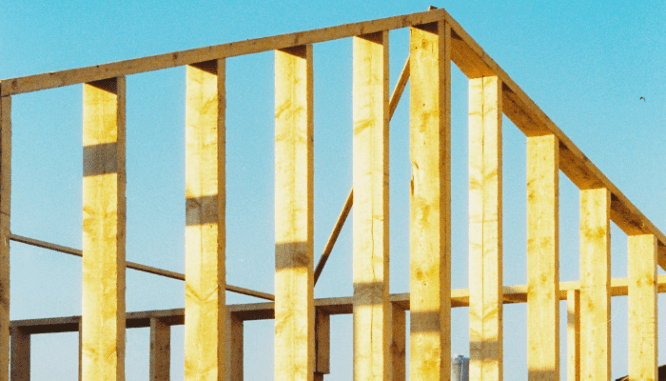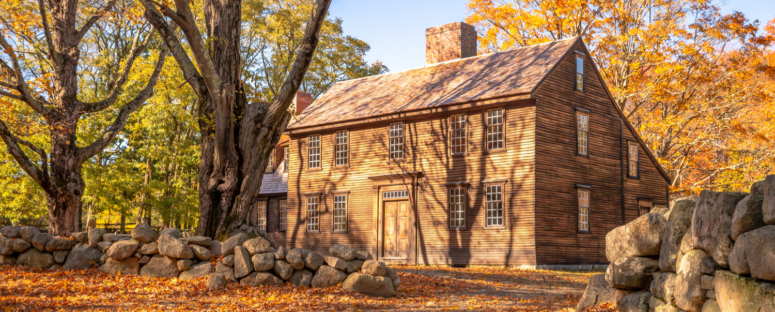What Is a Saltbox Home? This Slice of American History Withstands the Test of Time
- Published on
- 5 min read
-
 Eileen Wubbe Contributing AuthorClose
Eileen Wubbe Contributing AuthorClose Eileen Wubbe Contributing Author
Eileen Wubbe Contributing AuthorEileen Wubbe is a New York-based writer and editor covering finance and real estate.
It’s a beautiful, crisp fall day in New England and you and the family are taking a road trip to go apple picking. Fall foliage is in full effect with brilliant hues of orange, yellow, and red leaves glistening from trees lining the winding country roads. Along the way, you’ve spotted several unique looking homes with a sleek front and a steep roof in the back with a brick chimney stack, centered in the middle.
“What’s the story with those?” you wonder, thinking how cozy and historical they look. You notice the smaller area in the back of the house, and wonder how people fit in it or what its purpose is. You begin to envision yourself inside, baking pies in a farmhouse-style kitchen with exposed wooden beams. Chances are you’ve seen these homes, but never knew their name or history.
These homes are called saltboxes and, while they can be found throughout the U.S., they are predominantly in New England and are a great example of colonial architecture of the early settlers, dating as far back as the 1600s. While original saltboxes are typically in low supply, you’ll seriously want to consider the benefits this house structure can offer if you see one for sale.
We talked with a top real estate agent, architect and home designer in the New England area to understand the origins of this design, the characteristics that make it unique, common renovations, and how this simple and functional home has maintained its popularity hundreds of years later.

What is a saltbox house?
One of the most easily identifiable characteristics of a saltbox is its steep, pitched roof with unequal sides. These roofs, also referred to as “catslides” because of their somewhat triangular shape, were built to withstand cold harsh New England winters. Snow and leaves can easily slide off the roof, making removal practically a non-issue.
Saltbox homes vary in size and can typically range from 1,500 to 3,000 square feet. Newer updated versions tend to have additions or a garage added on.
The home is typically two stories in the front and one in the back and features a long, sloping gable roof. Saltbox homes are made from quality construction materials and can easily be updated and renovated. Construction is often a sturdy post and beam style, with timber framing, which supports the house with posts spaced fairly far apart (about 8 feet) to allow for large windows and high ceilings. The dense timber commonly used, such as American walnut, cherry or red oak, also tended to be Type IV grade and fire resistant, as opposed to a softwood, such as pine or spruce, that was more porous and susceptible to fires. Early settlers were onto something! On the downside, higher cost and potential for rotting could occur with post and beam. To help prevent wood from rotting there are treatments and sealants available.
In addition to its sleek, flat front exterior and practical roof, the saltbox style is said to have grown in popularity because of Queen Anne’s taxation of houses that were more than one story. A saltbox managed to avoid this tax because the back part of the house was just one story. The saltbox style eventually evolved to adding a lean-to, or a structure in which the rafters “lean” against another building or wall for support, onto the rear of the house to easily expand it for a growing family.
“If you look at historic homes, which we call antique homes over 100 years old, one of the hottest trends that is still pertinent is that historic homes hold their value,” says top-rated real estate agent Sara Littlefield.
“The replacement value of a historic home is higher than the price people can buy it at today. I think it’s all the moldings and the detailing that you can’t do today to replace it for the amount people are purchasing an antique or saltbox or farm-style or Victorian home.”
Original saltbox homes aren’t easy to come by these days. Littlefield suspects it’s because they are easy to renovate and add a structure, and buyers have already renovated them. But that doesn’t mean owners don’t retain a sense of their past.
“As one lives in the history of a home like this, one might ponder the evolution or the growth of the American heritage. You become stewards of history,” she says.

Why is it called a saltbox?
The saltbox house is named after wooden salt containers from the Colonial period. Before salt and pepper shakers, North American settlers would pound salt lumps with a mortar and pestle for cooking purposes. Salt was also used for preserving food. In North America and Northern Europe, saltboxes often hung on kitchen walls, and, for those living in cold or damp areas, saltboxes would hang near a stove or fireplace to keep salt dry. Saltboxes were considered a symbol of hospitality and a comfortable home.
Noteworthy saltbox homes
While there are many historical saltbox homes in New England, we want to highlight a few with especially interesting stories that showcase the humble beginnings and determination of early American settlers and U.S. presidents.
John Adams and John Quincy Adams birthplaces
Two U.S. presidents were born in saltbox-style homes just 75 feet apart on Franklin Street in Quincy, Massachusetts.
John Adams (our second president) was born on Oct. 30, 1735, in a two-and-a-half story wooden saltbox built by Joseph Penniman in 1681. The house is simply known as John Adams Birthplace. When Adams married Abigail Smith in 1765, they moved into the house next door, which was built by Samuel Belcher in 1663. Abigail gave birth to their second son and eventual sixth U.S. president, John Quincy Adams, in this house on July 11, 1767. The house contained a law office where he, Samuel Adams, and James Bowdoin drafted the Massachusetts constitution, but today the house is known as the John Quincy Adams Birthplace.
Pettengill House
A classic example of a saltbox house can be found on the Historic Pettengill Farm in Freeport, Maine. This 19th-century saltwater farm is on the estuary of the Harraseeket River, and is owned by Freeport Historical Society.
Pettengill Farm dates back to the Revolutionary War when brothers Joseph and Aaron Lufkin arrived in the undeveloped Mast Landing area. In 1810, Joseph and Aaron, a mariner, built the saltbox-style house on the land they previously purchased in 1801, now known as Pettengill Farm. Over the years the home changed ownership. Pettengill House is listed in the National Register of Historic Places and is surrounded by acres of fields and apple orchards, making for a picturesque visit.
Salt Box Museum
The Salt Box Museum, formerly called the Garrison/Dickinson/Genung House, is based in New Providence, New Jersey. Parts of it date back to the 1700s and contain artifacts from before the Revolutionary War. The museum had been the home of Augustus Garrison, a sexton of the New Providence Presbyterian Church and was located on church property.
“At some point, we don’t know when, there was part of a second house that was rolled and added onto the saltbox and incorporated into it,” says Rick Anderson, vice president of the New Providence Historical Society. “If you view the front of the saltbox, it’s obvious looking at it that the exterior front on the left side is different from the exterior on the right half. So, there were two houses that were put together.”
In 1966, the house was threatened with demolition to make way for a commercial building and, that same year, the New Providence Historical Society was looking for a place to call home. The historical society agreed to take the house and move it across the street, placing it on a foundation they built. Since then, the house underwent renovations to make the lower rooms look like a mid-1800s farmhouse, while the upstairs room was turned into an archive room.

Safe and sturdy characteristics
Saltboxes were built before balloon framing rose in popularity during the later part of the 18th century. The entire structure of a balloon framed house would be completed from the outside, without the floor, so exterior walls were continuous. It made for quick and less-expensive construction, but one significant problem with balloon framing was its fire hazard potential. If the home caught fire, wall cavities extending from the foundation to the roof structure acted as an open path for it to spread quickly, similar to a chimney stack straight up to upstairs bedrooms.
“Prior to balloon framing, it was post and beam construction, which is what saltboxes have,” says Arpita Muchhal of Arpita Muchhal Design, LLC. “The beam is a great fire stopper. Balloon framing structures can be made to be fire safe, but it is a big project. Inspectors will want to make sure you do the fire stopping and solid blocking.”
Renovating while preserving the saltbox spirit
While many admire the original structure of a saltbox home, buyers often opt to add additional storage space or structures to it.
“I love saltboxes. I think they’re very romantic,” Muchhal says. “My style is to meld the new and the old and make it livable.”
She notes that one common way people renovate a saltbox is with the addition of a shed dormer, which is an easier renovation, but can remove the distinct charm of a saltbox home. “The minute you put that dormer up, from the outside, you can see it used to be a gorgeous saltbox that now looks like any other colonial,” she says.
Muchhal prefers renovations that make a home unique, and noted that when millennials are house hunting, many are seeking a house that isn’t a cookie-cutter style.
Modernists and traditionalists like the saltbox design for its history and for its sleek, angular lines. Many older saltbox homes have been reworked by design firms to preserve the traditional exterior, but include more contemporary interiors and modern features.
Littlefield agrees that it’s important to keep some of the historical nature of a saltbox home when renovating. “You want to bring it into today’s world, but keep that history,” she says.
Kevin Latady, principal at Latady Designs, LLC, who specializes in the renovation of older and historic homes, renovated and expanded a 1750s saltbox home. He worked closely with the homeowners to help maintain the home’s original historic character and aesthetic. The renovations included adding a dormer addition in the back, remodeling the kitchen to create a space for cooking and entertaining, and converting a second floor storage area into a reading nook for children.
With so much history ingrained in saltbox homes, designers also try to preserve materials from the original structures as best they can when completing renovations. Original building materials may get dismantled, but they are often repurposed.
“Like people who worked on houses 200 years ago, we try to reuse whatever materials we can in our projects so that it’s repurposed,” Latady explains. “The builders’ hand imprint and energy is embedded in that material. I want to keep it as part of the spirit of the home by repurposing it.”
Whether you want to keep the original design or personalize and renovate, there is something everyone can appreciate about the historic saltbox home. If you’re in the market for this centuries-old style, having an expert agent on your side who knows the value and craftsmanship of these houses is key. Connect with a HomeLight buyer’s agent to help find a charming and unique saltbox home to call your own, and live in a piece of American history.
Header Image Source: (Keith J Finks / Shutterstock)
